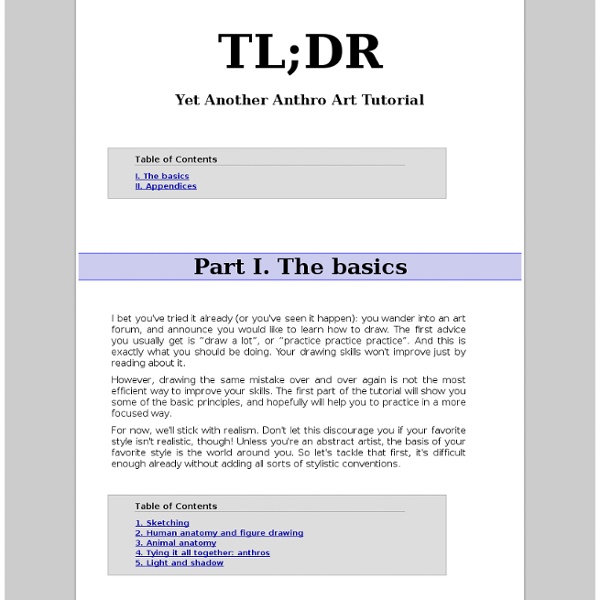Online Fine Art Instruction in Drawing, Painting, Pastel, Charcoal, and Lessons in Color Theory, Space and Composition
What I Believe/Don't Believe About Art: - "Talent" is basically a myth. I believe that sensitivity, inspiration, hard work and conviction are much more important in producing quality work.
LINKS to ARTISTS' SKETCHBOOKS ONLINE
1000 Hours of Drawing (Taylor O) sketchbooks | sketch 1000 JOURNALS PROJECT (Someguy) 8861 miles
dessiner
Affichage des articles dont le libellé est dessiner. Afficher tous les articles 26 février, 2014
Best Free Handwritten Fonts on the Web
Often in order to underline the informal nature of the project, where the text is involved, designers use handwritten fonts. Such fonts can give a personal touch to the whole project, ensuring reader’s predisposition and loyalty from the very first glance. From classical handwritten fonts to eye-catching sketchy fonts and to cute outlined typefaces – this collection of free handwritten fonts is a good source of high quality fonts for your designing projects. [ank]*
Stan Prokopenko's Blog
October 30, 2012 In this Halloween episode, I show you how to draw Jack Skellington from “The Nightmare Before Christmas” by Tim Burton. October 25, 2012 In this video tutorial I dig deep into the ears and explore ear anatomy and structure to show how to draw an ear. Learn how to simplify the complex forms of the ear.
Online Drawing Lessons - Composition and Design
Enhance the effectiveness of our online drawing lessons and improve the quality of your drawings by understanding the importance of Composition and Design. Learning to draw is not only about mastering the ability to draw what you see. Knowing how to create a balanced and harmonious composition within the borders of your page is also an integral part of making art. There are no official "rules" when it comes composing a visually interesting work of art. Simply use the elements of art (line, shape, form, texture & color) to create your desired outcome.
I DRAW COMICS Sketchbook & Reference Guide by Matt Marrocco
The I DRAW COMICS Sketchbook & Reference Guide is the ultimate tool for practicing the basics of Comic Book illustration, page design and the art of storytelling. We've designed the ultimate Comic Book Artist Field Guide by combining commonly used industry reference materials and 100+ sketching templates into a ubiquitous and iconic molelskine sketchbook form. By providing valuable Comic Book Industry background information and commonly used Comic Book terminology, no one is starting from scratch when learning with the I DRAW COMICS Sketchbook & Reference Guide. The beauty of the I DRAW COMICS Sketchbook & Reference Guide is that it gives you the ability to immediately apply what you've learned in the provided "Non-Photo Blue" templates.
How To Draw A Wave
This art tutorial, kindly donated by surfing comic strip illustrator and surf artist Bob Penuelas covers how to draw a wave the Wilbur Kookmeyer way! If you're like me, then you've probably spent a lot of time in high school class daydreaming and doodling a thousand perfect cartoon waves in your notebook. It's safe to say that ninety percent of us surfers have a habit of scribbling perfect waves whenever a pencil is in our hands.
untitled
How to Decoupage: 12 steps (with pictures)
User Reviewed Community Q&A Decoupage—from the French word découper, meaning to cut out—is a craft or art form that entails pasting cut-outs (typically paper) to an object and then covering them with several coats of varnish or lacquer. The process gives flat cut-outs an appearance of depth and makes patterns and pictures look as though they are actually painted on the decoupaged object. Decoupage is a fun and easy way to decorate just about any object, including household items from small vases to large pieces of furniture--the possibilities are endless. Best of all, decoupage can be learned fairly quickly in just a few steps.
Perspective
The Rules of Perspective Christopher W. Tyler
Enliighten
50 Clever Tutorials and Techniques on Traditional Drawing - Smashing Magazine
Advertisement Traditional drawing is certainly way harder than digital and it is true that people are able to progress much faster digitally, but one should learn the traditional type of drawing and painting before starting digital drawing, since it often lays out the foundation for screen design. This article contains a mixture of traditional drawing tutorials, drawing techniques and some methods for transforming and preparing your creations for screen design.
The Sight Size Method of Painting
By Melody on November 23rd, 2010 Still life arranged for sight size method in Melody Phaneuf's studio. The painting table on right shows the proper distance from the arrangement and easel for the Artist to stand.



